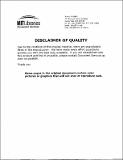Structural specificity in coiled coils : a and d position polar residues
Author(s)
Akey, David L. (David Lloyd), 1967-
DownloadFull printable version (5.146Mb)
Other Contributors
Massachusetts Institute of Technology. Dept. of Biology.
Advisor
Peter S. Kim.
Terms of use
Metadata
Show full item recordAbstract
Experimental studies were performed to determine the effects of single polar residues at the a and the d positions of a reference coiled coil, GCN4-pVL. The reference coiled coil is very stable in solution and exists as a mixture of dimers and trimers. The placement of single polar residues in the otherwise hydrophobic core of GCN4-pVL has dramatic effects on both stability and oligomeric specificity. The effects vary with regard to both the identity and the position (a vs d position) of the polar substitution. The d position is more sensitive to polar residues. Two residues, asparagine and glutamine, were found to be much more destabilizing when placed at d positions than any residues at the a positions. In addition to the known ability of a single asparagine at the a position to specify coiled-coil dimers, it was found that a single threonine at the d postion can specify a coiled-coil trimer. The crystal structures of four coiled coils, with either a single serine or threonine at either the a or the d position, were determined. These structures show that threonine residues tend to form intra-helical hydrogen bonds when packed in the coiled-coil core. Serine residues tend to show more variability in their packing when placed in the core positions. Polar residues can affect the local coiled-coil geometry. The most dramatic effect was as a result of serine residues at the d position in which in a local decrease in the supercoil radius of 0.5A centered around the buried serine position was observed.
Description
Thesis (Ph. D.)--Massachusetts Institute of Technology, Dept. of Biology, 2001. Includes bibliographical references.
Date issued
2001Department
Massachusetts Institute of Technology. Department of BiologyPublisher
Massachusetts Institute of Technology
Keywords
Biology.
